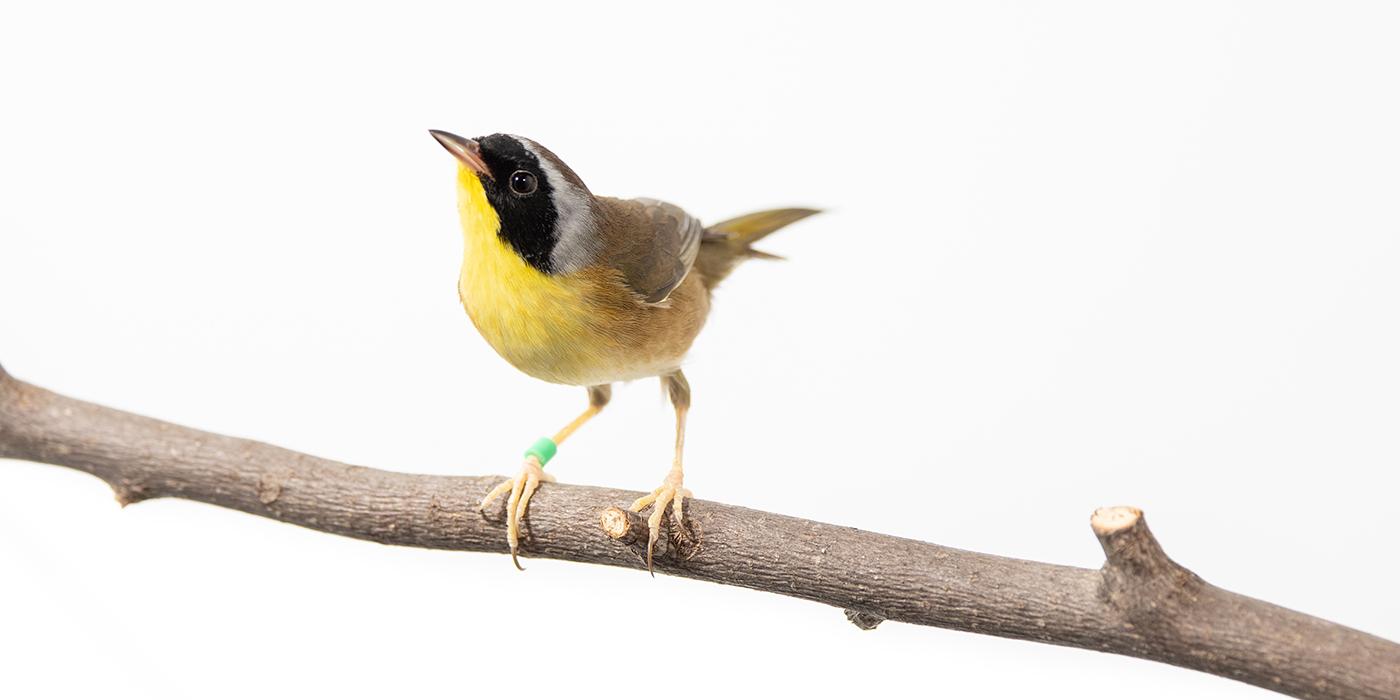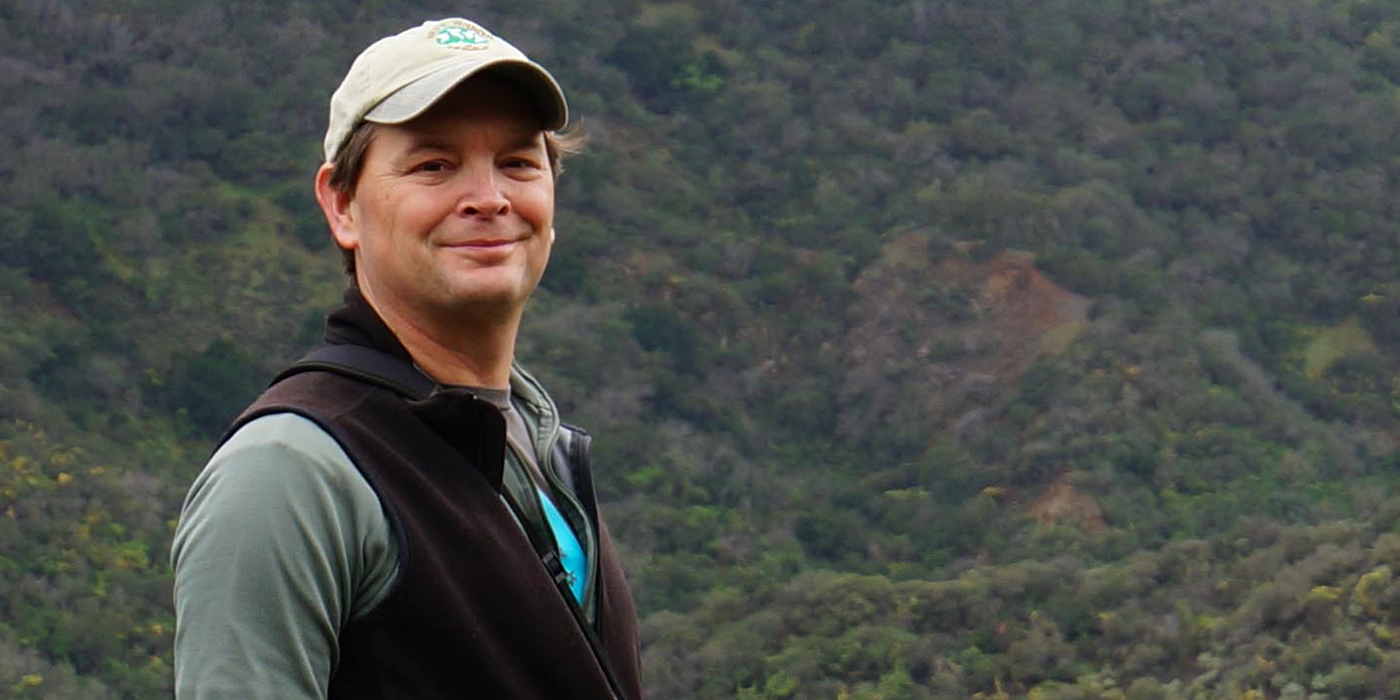Mexican Coffee Farm Expedition Blog
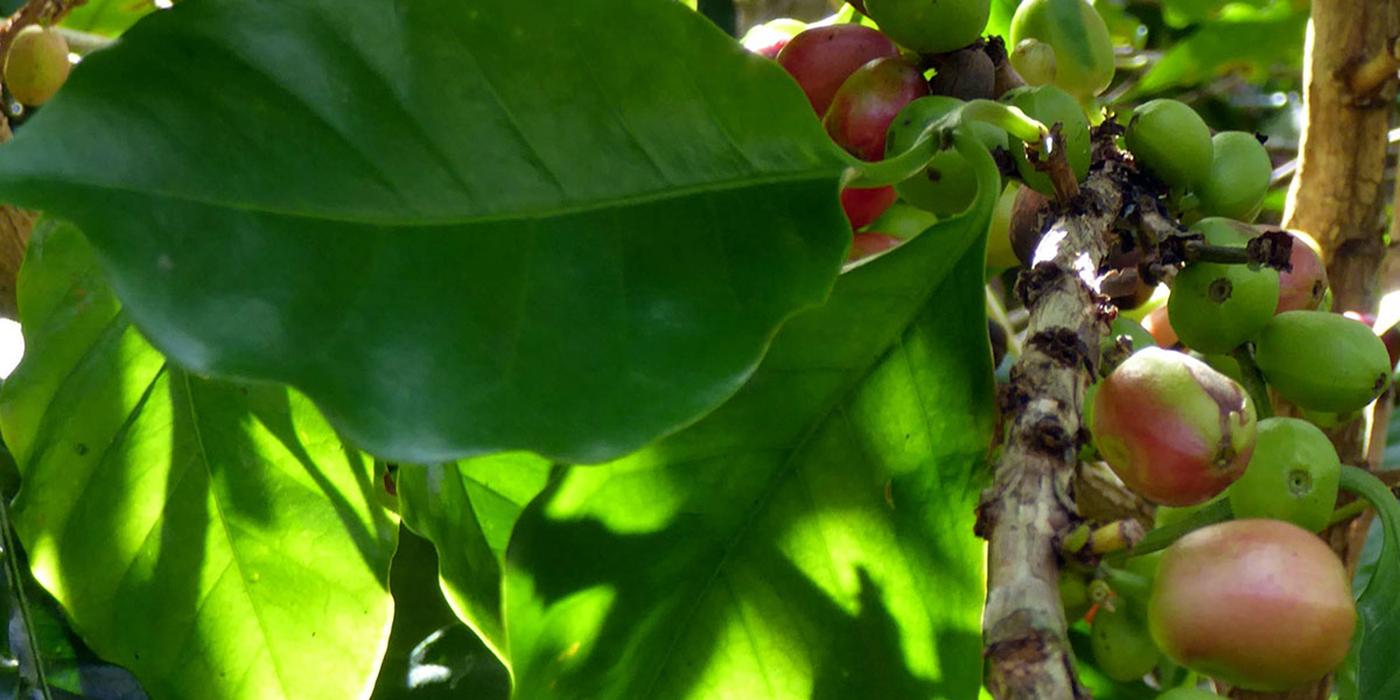
Mexican Mammal Study in Coffee Farms
Things we don't tell our mothers
We just completed the field research part of this project! I have to thank my great field crew for all of their hard work and tireless efforts. I couldn't have done it without them! We surveyed 23 sites within 4 habitat types of Smithsonian Bird Friendly coffee, conventional shade coffee, conventional sun coffee, and forested areas.
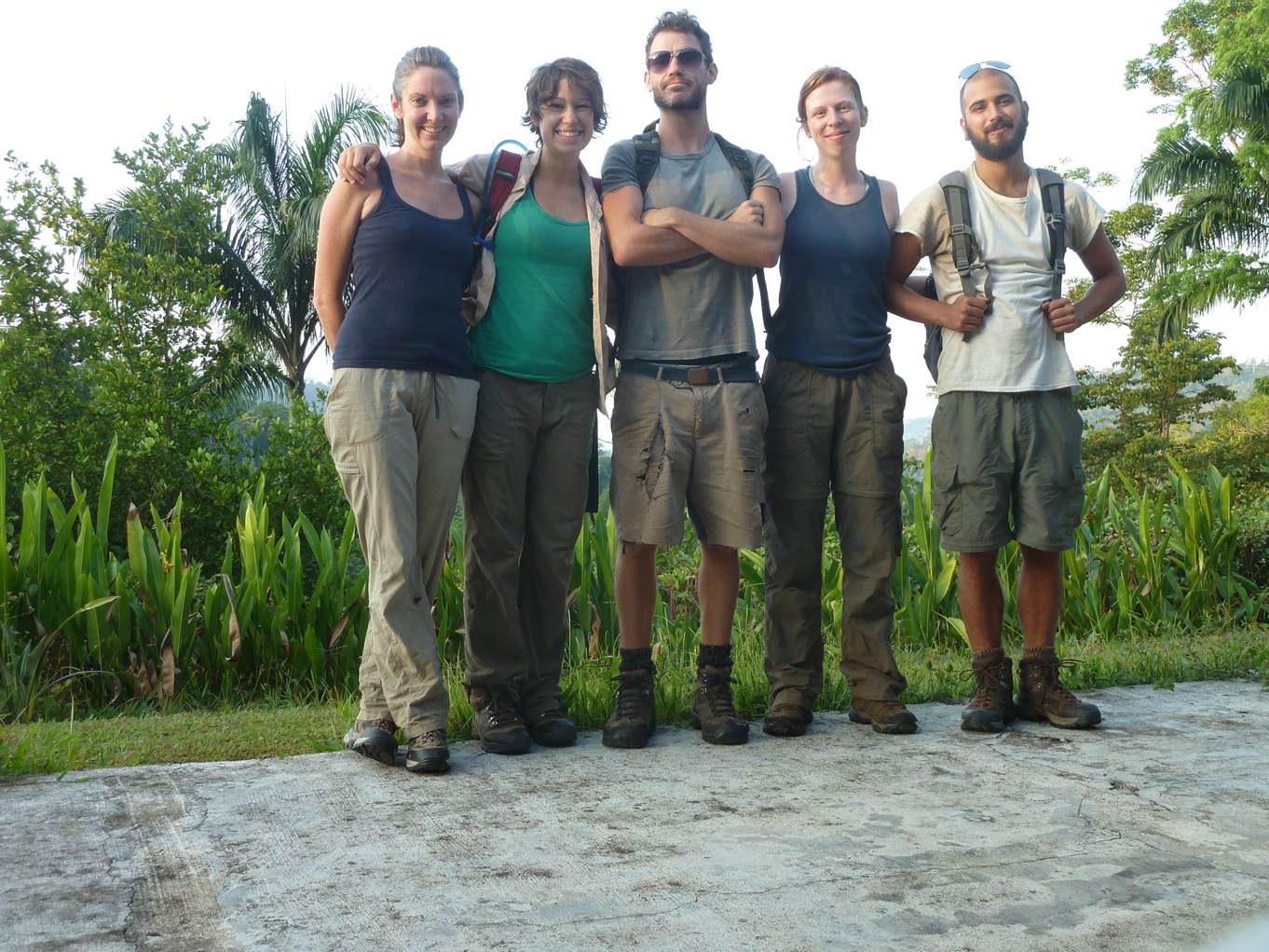
Field crew, from left to right: Amanda Caudill, Megan Banner, Stephen Brennen, Caitlin Campbell, and Tim Lima
We saw approximately 19 species of mammals from a combination of the small mammal traps and camera traps. We will confirm the field identification of these species after processing the DNA in the lab. The next phase of this project will be analyzing all the data that we collected to see which habitat parameters are important to the abundance and diversity of mammals in this area. I am excited to see what the results tell us!
I saved the last blog of this field work series to uncover all the things that we have kept under wraps for fear of worrying those back home. The tropics are home to a high diversity of species including those of insects, arthropods, and snakes. We have all had our fair share of insect bites—this is only to be expected in warm humid areas and we have had a couple of large furry spiders that have found their way onto our front porch.

Spider, photo by Megan Banner
We have only seen a handful of snakes during this research. I always try my best to educate about the dangers of snake bites—especially when trapping a main item on their menu. Megan found a statistic that says 70% of snake bites are by non-venomous snakes and 50% of bites by venomous snakes are "dry bites", meaning no venom is released. However, snake bites are particularly disconcerting when living in isolated/mountainous areas. There is a very poisonous coral snake in this region dubbed the "20-minute snake," which is terrifying considering that we live 40 minutes from the closest hospital…in reality though, we have rarely seen snakes.
Scorpions though are another story. Let me preface this by saying that most scorpions cannot kill an adult by their sting…that does not mean that it isn't painful. We had a couple of scorpions living in our bathroom water pipes. I'm not sure how that one works, but every once and again a scorpion would crawl out of the sink. Another one was found drown in the bathroom toilet. Caitlin was stung by a tiny scorpion when picking up her field pants from the floor. Luckily because it was so small, it did not have the full blown effects of an adult scorpion, but she said that it felt like a wasp sting which is definitely not pleasant.

Scorpion in sink, photo by Tim Lima
We prop our hiking boots upside down against the wall (i.e. sole of the boot facing up)—in theory this makes it harder for spiders, insects, and other things to crawl up into them…in theory. Additionally, we shake out our boots each morning in hopes that if the upside down method didn't work, whatever is in there will come out. One morning, I shook my boots out as usual and put them on. About 5 minutes later when heading up the driveway to our hiking path, I felt like I had gravel on top of my toes…which was strange. I asked everyone to wait a minute, so I could get the gravel out. I took off my boots, shook it and a big black scorpion fell out and scurried into a hole. I had to take a minute to breath before carrying on…it must have been pinned in the boot so that it couldn't reach its tail up to sting me. Lucky day.

Coffee farm in the mountains
We are all pretty worn out from our intense 3 months of hiking and traversing through the mountains of southern Mexico in search of mammals—but everyone is happy and healthy, so all of you moms can breathe a sigh of relief ☺ We collected a lot of valuable data that will be used to aid in the enhancement of mammal habitat in coffee landscapes.
The field crew profile this week is of Tim Lima. He recently graduated from the University of Rhode Island with a degree in Wildlife Conservation Biology.
Why were you interested in doing this field work?
I wanted to gain experience doing international field work and I have an interest in applied conservation towards sustainable agriculture.
Favorite thing so far:
Being able to talk to the farm managers/owners about their different practices, seeing and handling animals that other people usually get to see, and exploring this unique landscape.
Special skills:
Meticulous mammal measuring, identifying tree species, and keeping spirits high around the house
Mexican Mammal Study in Coffee Farms
In Search of Forest

Bob Rice and Megan Banner on bridge near our forest sites
We are in the middle of last sampling session! Although the focus of this study is to compare the mammal species communities among different types of coffee farms, it is always a good idea to incorporate forest habitats as a baseline, if you can. It has proven quite difficult though to find any contiguous forest in this coffee landscape. Our first sampling sites were in forested areas, but the habitat was fragmented. Most of the forested areas left in this landscape seem to be at the very tops of the mountains where the land is too steep and isolated to plant coffee.
For this last sampling session in the forest, we set out to see if we could find any contiguous forest in this area. We went further north to what was described as a "jungle" area near a coffee farm. We hiked up the mountain with a guide to see the property, after eating huge slices of papaya that were graciously given to us by our host. (Papaya is one of my least favorite fruits, but I smiled and ate as much as I could until one of my field assistants saved me and ate the rest.) The jungle area that we saw was at the very top of the mountain surrounded by coffee. So we continued with our exploration in search of contiguous forest.
We hiked through another coffee farm to survey an area land that looked like it could be a swath of forest, or at least not coffee. This one was very steep with hidden trenches under the vines. In terms of land use, it was mainly just overgrown vegetation and did not have characteristics of a forest (such as trees).
So then we hiked along a roadway in the valley that looked like it could have forest alongside its banks. We scaled up the steep cliffs through the vegetation, vines, and brush, finally making it up to the top only to find…more coffee. Finally, we found a strip of forested area between a river and roadway that, although it is still fragmented and not ideal, will have to serve as our forest sites. These small tracts are all that are left as forest in this landscape.

Peromyscus (mouse) species in a coffee plant. They are known to climb well, but are mainly terrestrial.
This week my advisor from the Smithsonian, Bob Rice, came to visit, see the study sites, and meet the field team. It was fun to have him here and show him all that we have been doing these past couple of months. It was also great to hear his insights on coffee cultivation and management. At one of the farms they are grafting coffee varietals in their nursery.
There are 2 species of coffee that we drink—arabica and robusta. Arabica is often thought to be of higher quality and have a smoother flavor than robusta. As a result, you will often find bags of coffee that boast "100% arabica coffee." Bob explained that at this nursery they were actually grafting arabica varietals onto robusta plants because robusta is often a hardier plant and is less susceptible to coffee diseases, such as coffee rust. The farm manager also told us that the roots of robusta are less attractive to moles who apparently eat arabica coffee roots.
The field crew profile this week is of Caitlin Campbell who recently graduated from the University of Vermont with a degree in Environmental Science with a concentration in Conservation Biology.
Why were you interested in doing this field work?
I love international field work and was excited to have this opportunity to live and work in the mountains of southern Mexico. It is also very fulfilling to work on a project with practical conservation implications.
Favorite thing so far:
Handling and viewing such fascinating wildlife, especially in the context of the broader ecosystem; finding unexpected non-target species like as birds, lizards, frogs in the Sherman traps; smelling mouse opossums (they smell like Aunt Jemima to me); and practicing my Spanish by chatting with coffee workers.
Special skills:
Rapid uneven-terrain navigation, scorpion wrangling, splinter removal, and enthusiastic waving.
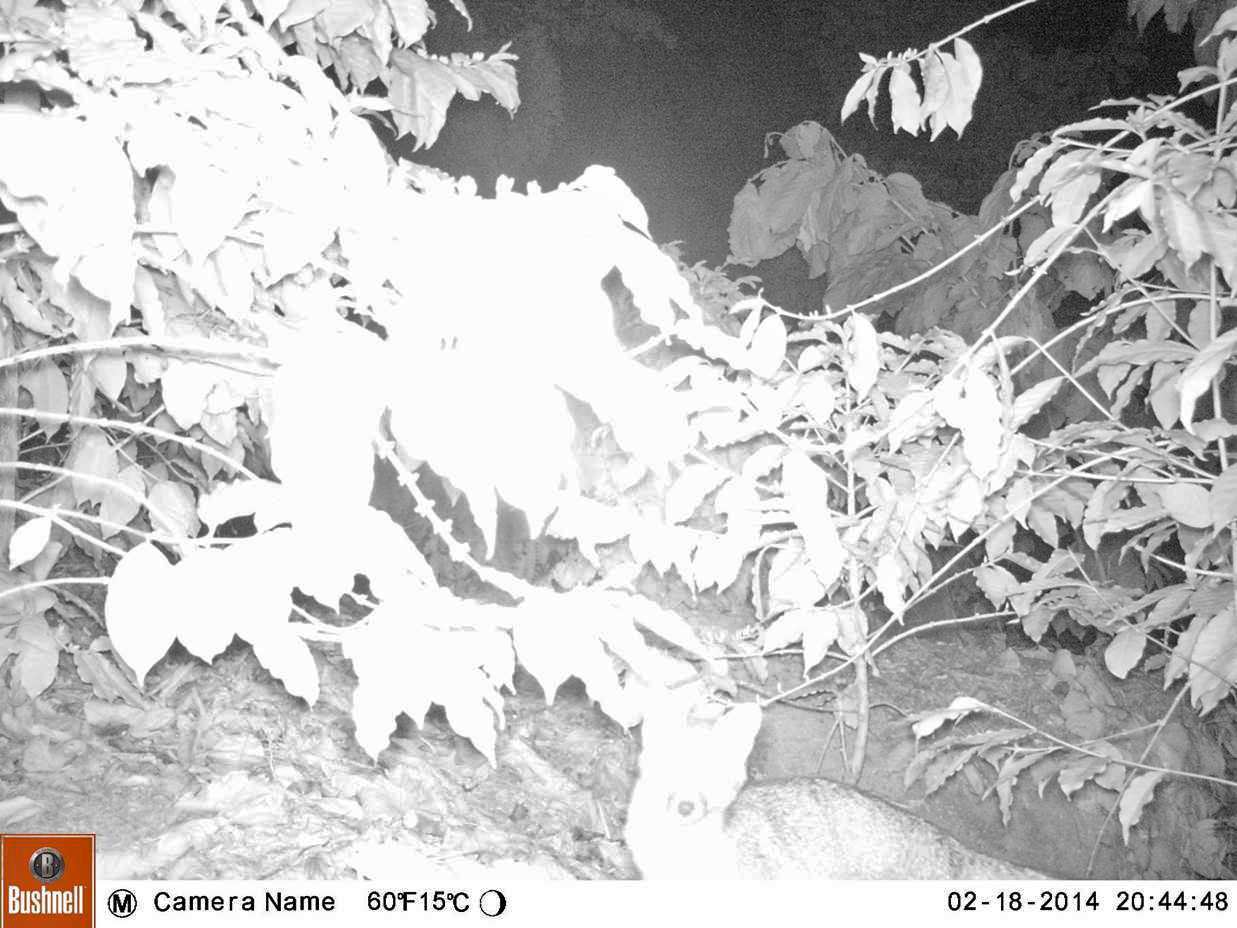
Urocyon cinereoargenteus (gray fox) from camera trap
Mexican Mammal Study in Coffee Farms
We completed our second to last sampling session yesterday and then went to a huge waterfall after we cleaned up the sites for this sampling session. It was so beautiful! We would have never found it if it weren't for the guide who works with us at one of the farms.

Field crew in front of waterfall
We treated ourselves to a lunch of beans, rice, tomatoes, and guacamole—a nice change from our constant field lunch of peanut and jelly. I tried to explain to the guide (to whom we bring a PB&J sandwich every day) that normally people from the US do not eat this much peanut butter. I'm going to need a peanut butter hiatus when I get back home.
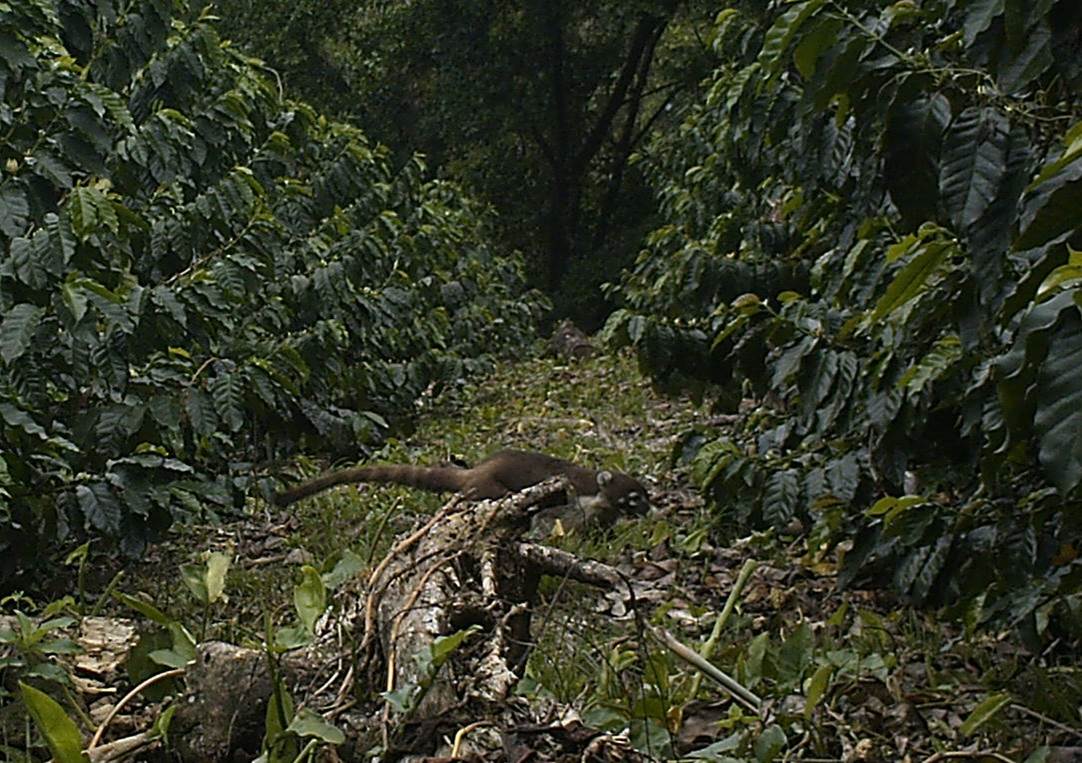
Nasua narica (white-nosed coati) from camera trap
Our camera traps again were really successful. We were able to detect deer, possums, coatis, agoutis, armadillo, and fox. For the small mammal traps, we saw our usual suspects—Reithrodontomys (harvest mice), Peromyscus (deer mice), and even a couple more Marmosas (mouse opossums) in the sun coffee.
The behavior of the mouse opossums is completely different from the mice which makes sense because although they are the same size as the mice that we catch, they are not rodents at all. As the name suggests, they are small opossums. They are much more alert in the bag that we use to weigh them and they occasionally do threat displays. I read that they sometimes do the "possum salute" which is holding up a clinched fist as a threat display—which I unfortunately have not seen.
Although it doesn't happen that often, it is not unusual to have unintended captures in the traps. In my previous work in Costa Rica, we caught toads, small birds, and large snails. In India, we caught a couple of chickens who would peck at the bait in the back of the trap and the door would close on their head.
For this study, our unintended captures have been lizards. It is a little startling to peek in the closed trap expecting to see a mouse and instead a lizard is staring back at you. They are sometimes tough to get out of the traps; then once they are out, make a frantic dash, sometimes running straight at you.
As for other non-mammals, there are two white geese that strut around one of the farms from this last sampling session. They are not afraid of anything. We saw them attack a lady who tried to hit them with her purse; one of them even grabbed her purse with its beak! Everyone escaped unharmed. Yesterday, we were driving behind them as they waddled down the middle of the road and the geese would not move. They actually started pecking and attacking the car!
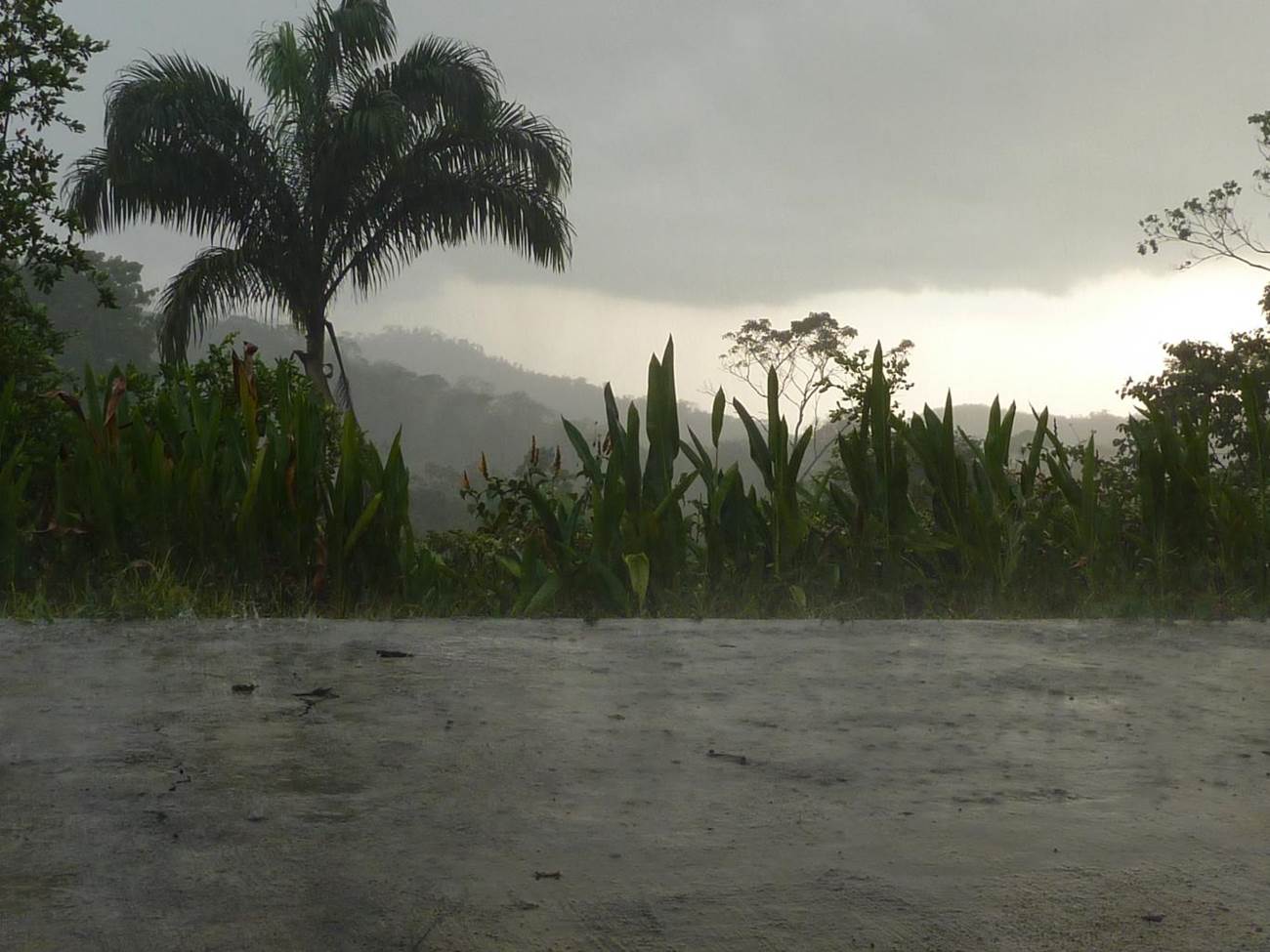
Afternoon rains
It has been in the mid-90s here recently (not to rub it in to all of you who have been hit with a cold, snowy winter this year)—so we appreciate the cool air that the afternoon rains bring. We have had heavy afternoon rains consistently this week. I've been told that these rains have come about a month early this year.
The field crew profile this week is of Stephen Brennen, our lone Irishman on the crew. He has a master's degree in Conservation Biology and had done field work all over the world.
Why were you interested in doing this field work?
I enjoy the opportunity to work in different countries and experience different habitats and species to broaden my knowledge of ecology. In this case, the chance to improve my Spanish and see more remote regions of Mexico was also attractive.
Favorite thing so far:
Seeing the differences between each coffee farm and how they are managed either organically or not. I also enjoy handling small animals which would not normally be seen by most people.
Special skills:
Exotic tree identification and finishing left over food.
Mexican Mammal Study in Coffee Farms
We have wrapped up the third sampling session this week with shade coffee and Bird Friendly® coffee sites. One of the coffee farms that is in the shade coffee category is in the process of reducing the shade cover over some parts of the coffee farm. This area was hit really hard a couple of years ago with a coffee fungus, commonly known as coffee rust, that wiped out whole crops of coffee. The owner is very environmentally conscious and until 2 years ago had a completely organic farm.
Now they use agrochemicals but are very selective about which ones they use. They have decided to use many of the shade trees for timber products in addition to growing coffee, in part to make up for the loss of revenue. He spoke to us about the balance of enough trees within the farms to stabilize the soil and harvesting them for timber products. Each farm here is divided into sections or "pantes" in Spanish. One of the aims of this coffee farm is to have a conservation easement in each of the sections, while reducing the shade trees in some parts of farm section.
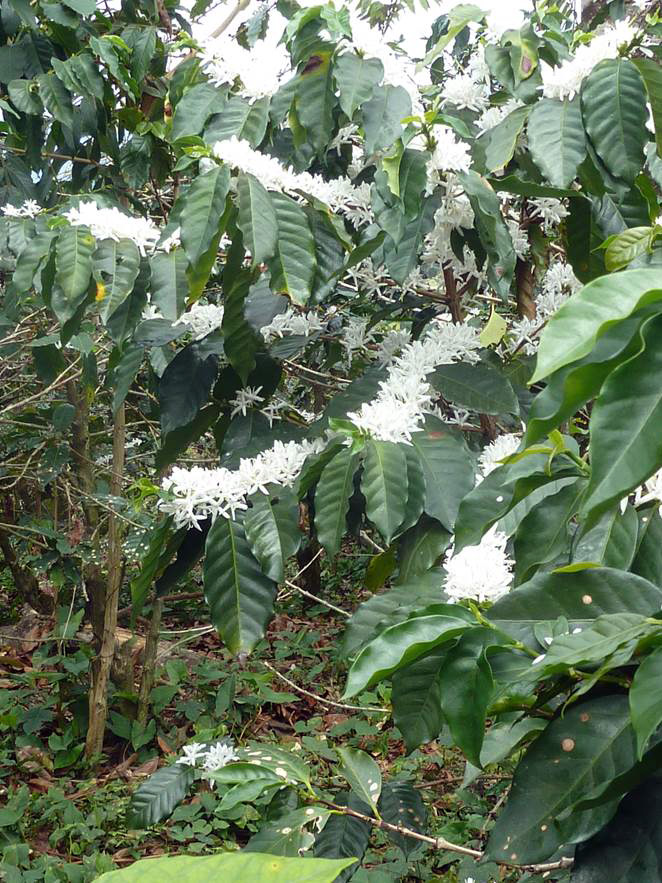
Coffee flowers
It has begun to rain here in the afternoons and the entire mountain side to bloom. The coffee flowers smell similar to jasmine and the scent permeates through the air. The coffee here flowers twice a year. Branches are full of small white flowers that will remain for about three days before drying up and falling off. The first day was pretty quiet in the field, but by the second day of the coffee blooms, the coffee farms were buzzing with bees.
The coffee berries will start to appear in June or July from this flowering. The berries will ripen by September and be harvested in September and October. The "coffee bean" is the seed of the coffee berry. The coffee berries themselves don't taste at all like the coffee that we drink. They taste a little bit like a green bell pepper. The fruit is stripped of the coffee seed which is washed, dried, and roasted to become what we know as a coffee bean.
I was worried the rains coming in would cause us to have wet little mice in the traps (see this article). Luckily since it has mainly rained in the late afternoons/early evenings before most of the mice are active, they have kept dry in the traps. Our sites have not been that slippery either because of the rain, but we all still have our fair amount of bumps and bruises due to the uneven terrain, hidden logs beneath the brush, and the shin-height stumps.
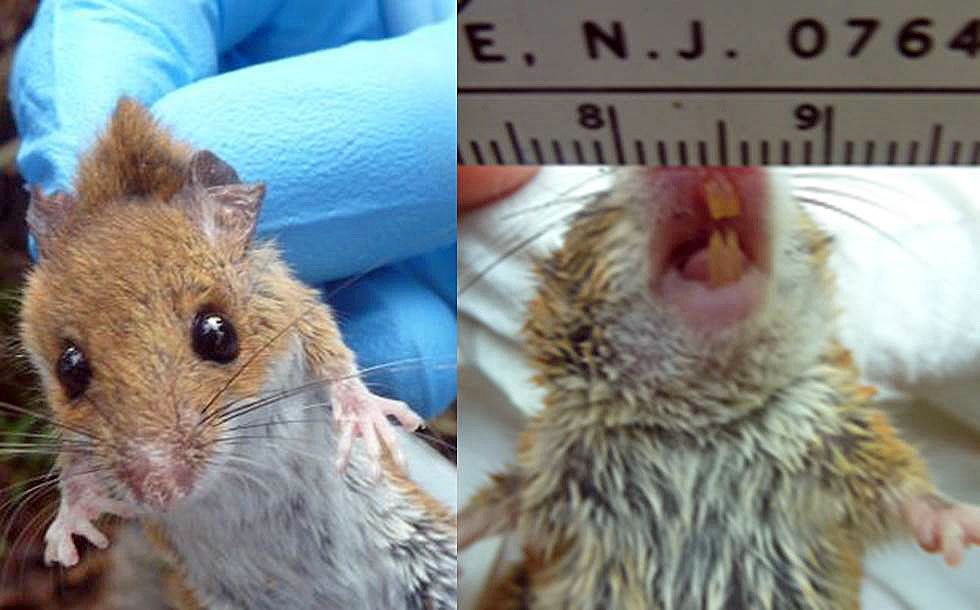
Reithrodontomys sp. (Harvest mouse)
There are some species of mice that are about 10 grams in weight—which is weight of 2 quarters (I measured with a scale). They are tiny. One way to distinguish Oligoryzomys from Reithrodontomys species is to check to see if they have grooves in their front teeth. We have seen both of these genera this study session—which is really cool.
For the next couple of entries, I will include a brief profile of my field crew for this research trip. The first is Megan Banner. She worked with me on a similar mammal research project in Costa Rica and is from Rhode Island. She has a degree in Microbiology and ultimately is interested in becoming a doctor with a focus on tropical infectious diseases.
Why were you interested in doing this field work?
I love traveling and being outdoors, and I had a really great time doing field work previously. Outside of this work I have limited opportunities to learn about ecology and conservation biology and I think it's interesting and really important.
Favorite thing so far:
Meeting and talking with the different coffee estate owners, to hear stories of people who've been in the area for a long time and have different perspectives on land management.
Special skills:
Feisty mammal wrangling, pothole avoidance, and spot-on soup spicing.
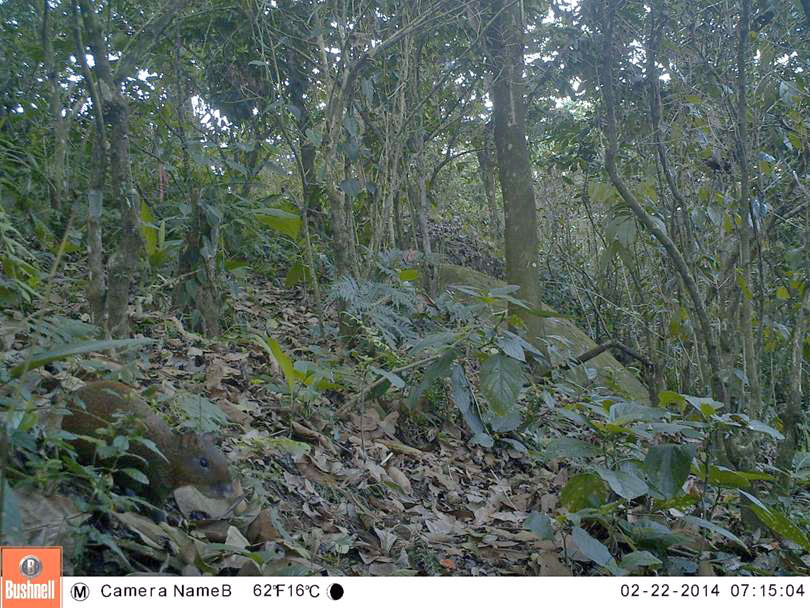
Camera trap photo of Dasyprocta punctata (Agouti)
Mexican Mammal Study in Coffee Farms
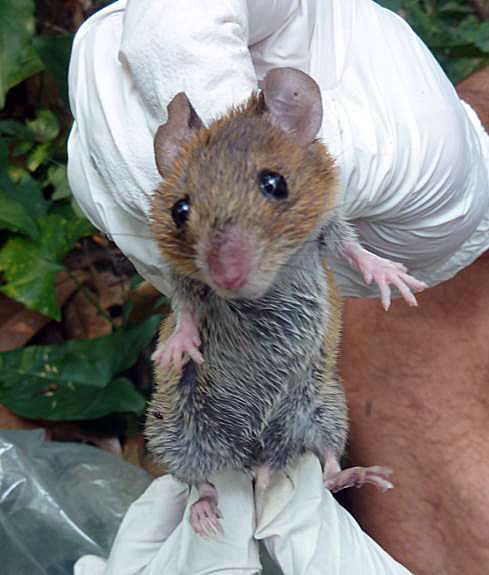
Rice rat (Handleyomys sp.)
We wrapped up Session 2 with the highest trap success rate that I have had in my research career thus far! The trap success rate is a measure of the effectiveness of the sampling effort. For small mammal studies, it is the total number of captures (including recaptures) divided by the sampling effort which is the number of traps set out times the number of sampling nights.
Trap success rates in coffee are usually quoted as approximately 1 to 4 %. In the shade coffee, we had trap success rates ranging from 5.6 to 12.8 %!
We found about 6 different species of small mammals for this second session. I say "about" because there are a few that we have captured that may be 2 different species or may be a subspecies of the other. This will be sorted out when we analyze the DNA samples.
Many of these little critters are not distinguishable from each other in the field, so it is important to have DNA samples so that we can understand the diversity of mammals. Personally, I use the least invasive methods possible for my research. We take salvia samples by swabbing the mouse's mouth with a tiny cotton swab which is about the size of a felt-tipped pen and also by taking a couple hairs of fur. It is amazing that we can identify the species in the lab just based on these samples.
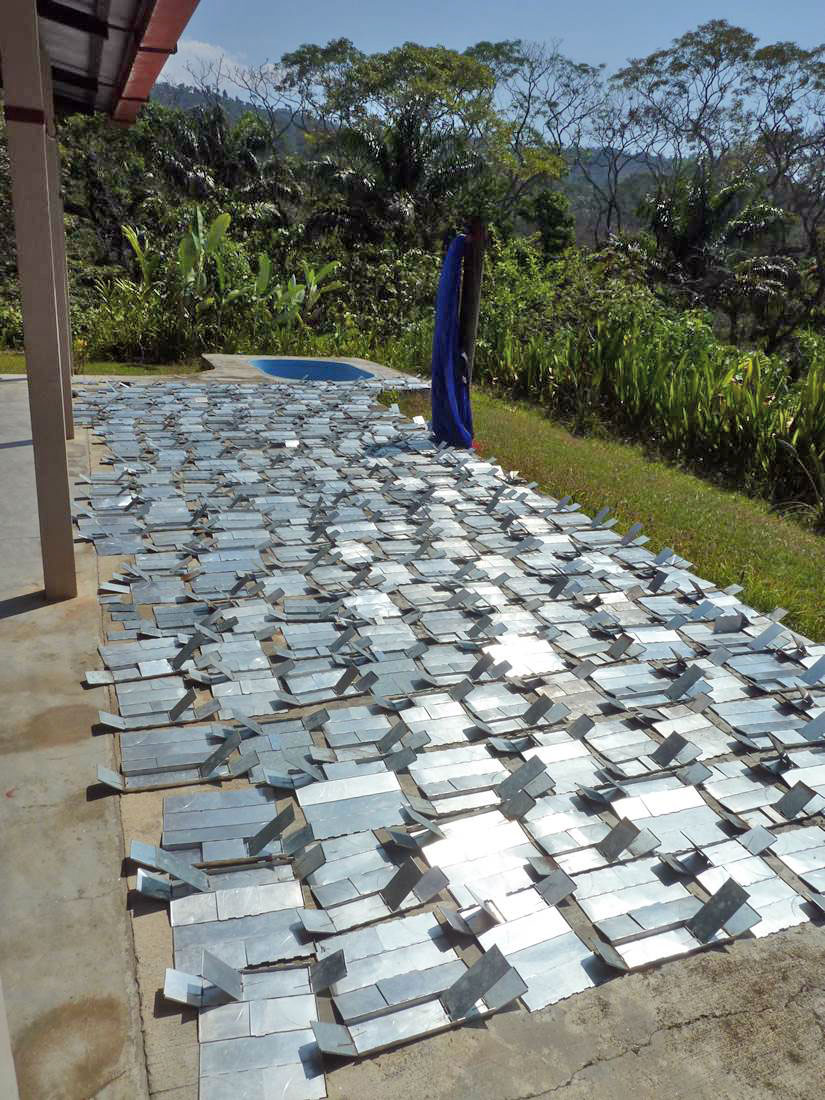
Traps drying.
At the end of each session, we rinse and clean all the traps. I think that I can safely say that this is the least favorite activities of my field crew. We open up all the traps, then rinse and scrub them with a toothbrush. This ensures that there is no bait molding behind the trap door and that all the hinges and corners are clean and functioning, ready for the next round. We first set the traps out to dry, then comes the task of pinning them all back together. It is a time-consuming, tedious task—especially when we have 300 traps to clean and pin.
We are at the midpoint of this field research project. We have 5 sampling sessions total and we are right in middle of session 3. I have noticed in my past field work that the midpoint is one of the toughest parts. The novelty of the project is starting to wear off and you still have a lot more field work ahead of you—you know the area a little bit, are familiar with the sites, have seen a lot of different animals, the camera traps have lost their luster, your muscles are getting tired.
This is when it is important to revisit your focus and motivation, to be aware that you are a little worn out and make sure that you are paying attention to details as much now as you were at the beginning. For example, I always notice that at the beginning of a field season, I take photos of everything. I have multiple pictures of all the sites from all different angles, all the coffee plants, tons of mice photos…then as the research progresses, the number of photos slowly begins to decrease.
I make a conscious effort at this point to take multiple photos each session (it is on one of the many to-do list on the wall for each site) and I also make sure to take a step back when doing our daily hikes and notice our beautiful surroundings and appreciate the fact that we are able to be here and hopefully contribute to the conservation of these important habitats.
Mexican Mammal Study in Coffee Farms
One of the fun parts of field ecology is that natural systems do not always behave in the way that you would expect. My doctorate advisor liked to say that wildlife does not always read the instruction manual. This has been the case in our study so far. We started off with forest plots and had really low capture rates where theoretically there is supposed to be the highest abundance and diversity of mammals. For this sampling session, we are sampling 2 habitats at once: sun coffee and Bird Friendly® shade coffee. Our capture rates have skyrocketed!
I have several working theories as to why this could be case, but we will have to wait and see how the rest of the study unfolds. We will be sampling forest habitats for the last session and it will be interesting to see which theories hold true.
One of our habits that we are sampling this session is sun coffee. It is mainly a swath of coffee plants with sparsely planted trees in the farm for shade. Our camera trap records temperature and one photo during the day said it was about 110 degrees F! The farm that we are working on does have some areas of more shaded coffee as well as some natural areas within the site. This farm is the most representative of a typical coffee farm in terms of the agrochemical use and shade management.
Study site is a coffee farm in Mexico near the border with Guatemala.
The other habitat is Bird Friendly® shade coffee. This label requires that the farm be organic and have a diverse shade tree structure. The farm we are working on seems like it is almost forest habitat but with coffee planted as the understory. This is the first time in doing coffee research that I have had to ensure that there are enough coffee plants within our site to qualify as a coffee plot.
When we were measuring one of the mice that we captured the other day, we heard something jumping through the vegetation on the hillside above us. We couldn’t see what it was then, but later when we checked the camera traps, we got a picture of this red brocket deer (Mazama americana).
Red brocket deer (Mazama americana) from camera trap.
While doing the research, we are living in a house in the mountains on a coffee farm in the area. There are a lot of little towns around here in the mountains but the closest grocery store is an hour away. We have been doing really well with planning our meals and making weekly trips into town to buy groceries. All of the sites require a lot of hiking.

Sunset from our house in the mountains.
For one of them this session, we are hiking about 6 miles a day. So our grocery cart is definitely filled to the top with enough food to feed five hungry field researchers for the week.
We have one more week at the Bird Friendly® and sun coffee sites then we are onto another farm that has shade grown coffee but is not completely organic. I am excited to see how the diversity of the mammals compares across these habitat types!
Mexican Mammal Study in Coffee Farms
Our day starts before sunrise. It is cool and peaceful in the mornings and you can still see the moon with all the stars in the night sky while eating breakfast. The mammal traps that we use are small metal boxes that heat up quickly in the tropics, so we make sure to arrive early in the morning to check the traps and release the mammals before it gets too hot out. We are all hungry again by 9:30 a.m. from hiking around for a couple of hours and eating breakfast so early. We usually break to have a sandwich, our second breakfast, after checking all the traps and before continuing on with other parts of the field work like vegetation analysis to characterize the habitats for each site.
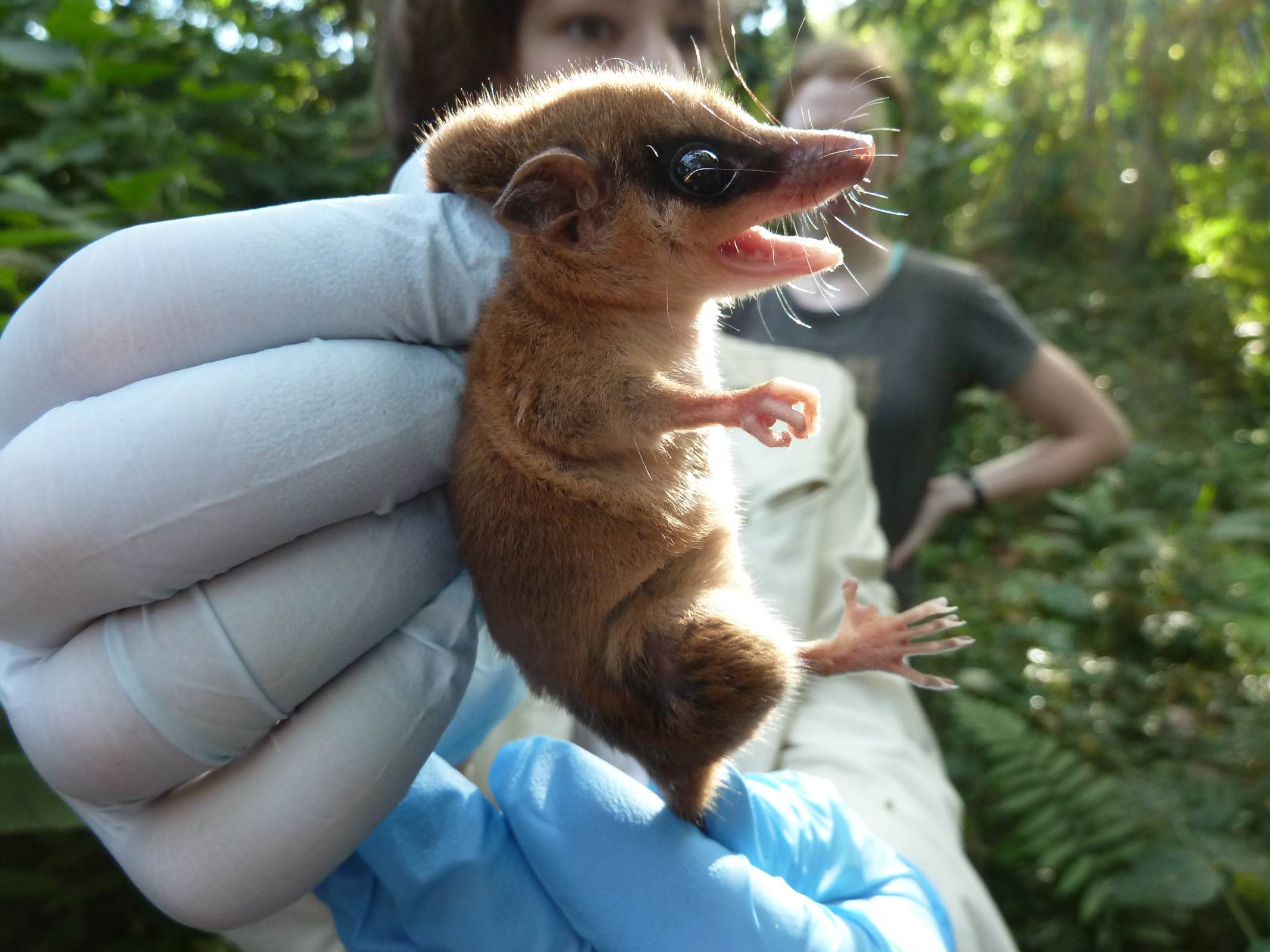
Mexican Mouse Opossum
We have had a slow start this first week of mammal trapping. It is not unusual for there to be few captures in the first couple of days of trapping, but I thought it would have picked up by now with this being our 6th sampling night. We did catch a Marmosa mexicana, which is an opossum the size of a mouse.
They are amazing creatures with opposable thumbs on their hind feet and prehensile tails. This little one was only 22 grams (approximately 4 U.S. quarters). In the couple of mammal studies I have seen from this area, Marmosa species haven't been noted, so it is pretty cool that we got to see one.
Common Opossum (Didelphis marsupialis) from camera trap
From the camera traps, we have gotten photos of nine-banded armadillos, coatis, opossums, and agoutis so far. I'm glad the cameras are working well, at least. It is tough work setting up trap grids, then checking and baiting traps on a daily basis. It can be a little discouraging when you don't get many captures. I have a great crew though and everyone has a positive attitude which is so important when doing field work. Nothing ever really works out as planned in the field—which can be both the best thing and the worst thing about field work. The days can be long and physically exhausting, but it is also a ton of fun—you get to be outside every day, hike around, and see some really cool wildlife that you might not ordinarily get to see. We have 4 days left at these site locations for the first sampling session—hopefully things will start to look up and we will get more captures in these final days!
Mexican Mammal Study in Coffee Farms
Coffee is an important cash crop worldwide. It is the second highest traded commodity next only to oil. The lives of millions of people are intertwined in this cash crop. Additionally, many studies have shown that coffee farms can serve as refuges for wildlife. The way that coffee is grown varies drastically from highly managed sun coffee to coffee that is basically grown in the understory of forested areas. However, most of the research for coffee as habitat has focused on birds and insects with few studies that seek to understand if coffee can also provide a refuge for mammals. My research aims to understand how mammals use coffee landscapes and what habitats parameters within coffee farms are important to enhance mammal habitats.

We just wrapped up our first week in the field here in Chiapas, Mexico. We will be studying mammal diversity in 3 different types of coffee farms:
- Smithsonian Bird Friendly certified shade grown coffee (which is also organic);
- Shade grown coffee that would not meet the Bird Friendly certification standards; and
- Coffee grown with little or no shade, also known as sun coffee.
Forested areas will also be sampled for mammal diversity and act as our baseline.
My 4 field assistants and I hiked about 4-5 hours a day this week to see the sites, mark locations for trap grids in the GPS, and flag that pathways so we can hopefully find our way back there when it is time for trapping. The hikes can be exhausting in this tropical mountainous region—but the views once you get to the top of the mountains are breathtaking. We have met so many great people already. We have spoken with a couple coffee estate owners in the area and have learned about the challenges of growing coffee. Most of the farmers told us they recently started diversifying their crops because coffee rust hit this area hard 2 years ago destroying acres of coffee plants. Some farmers have started growing and selling ornamental flowers in addition to coffee, while others have begun to sell timber products from the trees on their coffee farms.
Tomorrow marks the first day of mammal trapping. The first sampling session will be in the forest near the coffee sites. We will set up three 50x50 meter trap grids with 50 Sherman traps for the small mammals (mice, rats, and maybe some shrews) and one camera trap activated by heat and motion for the medium and large mammals. There are rumors of a puma that comes through here every year around this time…it would be amazing to get a photo of it with the camera trap!

